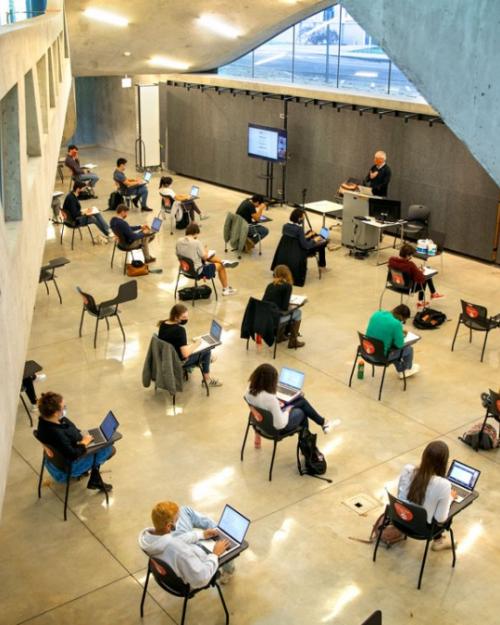In the fall of 2019, months before the coronavirus pandemic hit, an average Cornell student interacted with about 530 peers in classrooms each week. Through courses alone, more than 90% of students were linked by three or fewer degrees of separation.
A year later, in the midst of the pandemic, the university’s “small world” enrollment network looked very different – smaller, less connected and more fragmented, according to a new analysis by Cornell sociologists.
Less than half of all enrolled students took an in-person class in the fall of 2020, they found. Of those, the average student saw just 65 others in classrooms each week. The share of students connected indirectly through in-person classes dropped to 55%. And ties among students were more often with others in the same field of study.
The analysis shows how the shift to a hybrid mix of online and in-person instruction – a model many colleges and universities adopted last fall to help minimize spread of the virus – altered the usual patterns of campus life and learning.
“There was a lot less connectivity in the face-to-face enrollment network, and as a result, a lower risk of viral transmission through courses,” said Kim Weeden, the Jan Rock Zubrow ’77 Professor of the Social Sciences in the College of Arts and Sciences (A&S). “That also changed the student experience significantly.”
Weeden and co-authors Ben Cornwell, professor of sociology (A&S), and Barum Park, assistant professor of sociology (A&S), reported their findings in “Still a Small World? University Course Enrollment Networks before and during the COVID-19 Pandemic,” published Jan. 21 in Sociological Science.
The study follows one published last May, in which Weeden and Cornwell found that the many close and overlapping connections between students during normal times – typically a feature of campus life – risked facilitating transmission of the virus, if no mitigations were put in place.
Instead, upon reactivating its Ithaca campus last fall, Cornell required students, faculty and staff working on campus to wear masks, practice physical distancing and participate in a surveillance testing program. Large classes were moved online, including many of the introductory courses that are required by multiple majors or help fulfill general education distribution requirements.
The researchers suspected that was what drove the increased clustering, or fragmentation, of in-person students by fields of study in the fall of 2020, which nearly doubled compared to a year earlier.
“This fragmentation,” they wrote, “is a predictable, if unintentional, consequence of the shift to hybrid instruction.”
In another measure of how the in-person enrollment network grew less connected, the researchers found that the average number of steps connecting any pair of students – because they took a class together (one step) or had a third classmate in common (two steps) – grew by almost a full step, to 3.4 steps. That was just among the roughly 11,700 students who participated in at least one in-person class in Ithaca in the fall of 2020, not including the nearly equal number who took classes only online or were located elsewhere, and thus no longer part of the face-to-face enrollment network.
The researchers’ enrollment data didn’t allow them to assess how the pandemic influenced student networks outside the classroom in residence and dining halls, activities and athletics. Nor could they evaluate how face-to-face classes becoming smaller and more concentrated by majors, and fewer pairs of students taking multiple classes together, affected their educational experience.
But Weeden said that when planning for the fall 2021 semester, university leaders and faculty need to understand the changed structure in which students learned last fall – and again this spring – and think about its potential long-term impacts. First-year students in particular, she said, faced a very different environment in which to make connections with peers and faculty, something that could have ripple effects throughout their time on campus.
“What Cornell and what most universities had to do this past fall was certainly necessary to help to reduce the risk of a pandemic spreading in the college community,” she said. “Nonetheless, there could be downstream consequences that we’re going to learn about in the next three or four years, in terms of the impact on student learning and the impact on community, even when we do get back to something that looks a little bit more like normal.”
The research was supported by a rapid response grant from the Cornell Center for Social Sciences.




